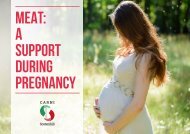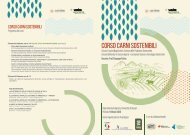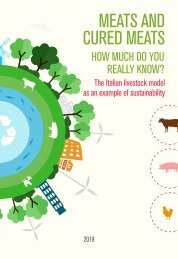Novel antibiotics effective against grampositive and -negative multi-resistant bacteria with limited resistance
Antibiotics are a medical wonder, but an increasing frequency of resistance among most human pathogens is rendering them ineffective. If this trend continues, the consequences for public health and for the general community could be catastrophic. The current clinical pipeline, however, is very limited and is dominated by derivatives of established classes, the “me too” compounds.
Antibiotics are a medical wonder, but an increasing frequency of resistance among most human pathogens is rendering them ineffective. If this trend continues, the consequences for public health and for the general community could be catastrophic. The current clinical pipeline, however, is very limited and is dominated by derivatives of established classes, the “me too” compounds.
You also want an ePaper? Increase the reach of your titles
YUMPU automatically turns print PDFs into web optimized ePapers that Google loves.
<strong>Novel</strong> broad-spectrum <strong>antibiotics</strong> for combating <strong>multi</strong>drug <strong>resistance</strong><br />
Fig 1. Two pseudopeptides are active <strong>against</strong> gram-positive <strong>and</strong> -<strong>negative</strong> MDR <strong>bacteria</strong> in murine sepsis <strong>and</strong> skin infection models <strong>and</strong> are<br />
nontoxic. (A) Biomimetic design of <strong>antibiotics</strong> from a <strong>bacteria</strong>l toxin [9]. Selected residues from theS.aureus toxin were cyclized, <strong>and</strong> unnatural<br />
amino acids (C) were incorporated to synthesize those new <strong>antibiotics</strong>. Data associated <strong>with</strong> this panel can be found in S1 Fig. (B) Kill curves of<br />
MRSA using Pep16 (red), Pep19 (green), <strong>and</strong> vancomycin (blue) at concentrations 30-fold above the MIC are compared to untreated <strong>bacteria</strong> (black).<br />
Means <strong>and</strong> st<strong>and</strong>ard errors of the means are representative of 3 independent biological replicates. Data associated <strong>with</strong> this panel can be found in S3<br />
Fig. (C–D) Pep16 <strong>and</strong> Pep19 antibiotic activity <strong>against</strong> MRSA strain Mu3 (red) compared to their low toxicity on human erythrocytes (blue bars) or to<br />
human kidney cell viability (green). Pep16 <strong>and</strong> Pep19 concentration range is from 0.5 to 512μM. Data associated <strong>with</strong> this panel can be found in S4<br />
Fig <strong>and</strong> S2–S6 Tables. (E) Overview of the mouse sepsis experiment. (F–G) Kaplan-Meier survival probability plots of mice infected <strong>with</strong> either MRSA<br />
<strong>with</strong>out treatment (black), or <strong>with</strong> 1.5 mg.kg −1 Pep19 (green) or vancomycin (blue). In a sepsis protection model, groups of 5 Swiss mice were<br />
inoculated <strong>with</strong> approximately 5×10 8 MRSA <strong>and</strong> treated either 3 h (F) or 15 h (G) post infection. Survival was monitored for 14 days after infection<br />
(panel d; x-axis), <strong>and</strong> the results are from 10 mice. The experiment was performed twice <strong>and</strong> the data combined. Data associated <strong>with</strong> these two panels<br />
can be found in S3 Fig. (H–J) Kaplan-Meier survival probability plots of severe sepsis assays (nearly all untreated infected mice killed <strong>with</strong>in 2 days<br />
post infection) <strong>with</strong> mice infected <strong>with</strong> approximately 2.10 9 CFUs MRSA either <strong>with</strong>out treatment (black) or <strong>with</strong> 4 repeated doses (0.5 mg.kg −1 ) of<br />
Pep16 (red), Pep19 (green), vancomycin (blue), or brilacidin (purple). The results are from 5 mice per assay, <strong>and</strong> the experiment was performed twice.<br />
Mice monitoring was performed for 5 days. (K) Overview of the mouse skin infection experiments <strong>with</strong> eitherS.aureus orP.aeruginosa. (L)<br />
Treatment of cutaneous abscesses from MRSA in mice using Pep16, Pep19, or vancomycin. Mice were infected <strong>with</strong> approximately 2×10 9 MRSA <strong>and</strong><br />
treated by IV 24 h post infection <strong>with</strong> a saline solution (black) or <strong>with</strong> 1.5 mg.kg −1 of Pep16 (red) or Pep19 (green) or vancomycin (blue). Lesion sizes<br />
<strong>and</strong> the CFU counts per abscess, plotted as individual points, were determined 6 days post infection (10 mice per condition). The abscess photos<br />
below the graph correspond to each experimental value shown in the graph as empty symbols. Intracellular ATP levels fromS.aureus in the “normalgrowing”<br />
(empty histograms) versus SCVs (filled colored histograms) collected from the mice skin abscesses (lower panels). (M) Treatment of<br />
cutaneous abscesses induced byP.aeruginosa in mice using Pep16, Pep19, or colistin. Mice were infected <strong>with</strong> approximately 108P.aeruginosa <strong>and</strong><br />
treated <strong>with</strong> repeated doses post infection <strong>with</strong> a saline solution (black) or <strong>with</strong> Pep16 (red, 30 mg.kg −1 ), Pep19 (green, 30 mg.kg −1 ), or colistin<br />
(orange, 9 mg.kg −1 , lower panel). The CFU counts per abscess, plotted as individual points, were determined 3 days post infection (5 to 8 mice per<br />
condition). The abscess photos below the graph correspond to each experimental value shown as empty symbols. Mann-Whitney was used to calculate<br />
the differences between the groups; 0.05


















